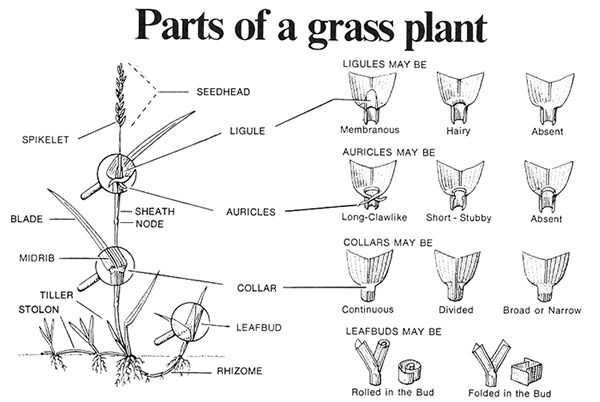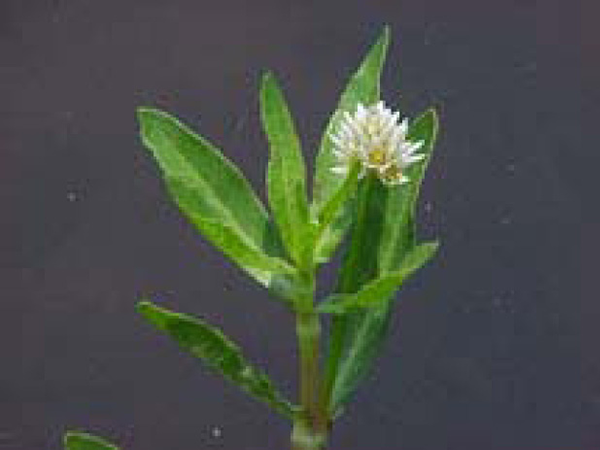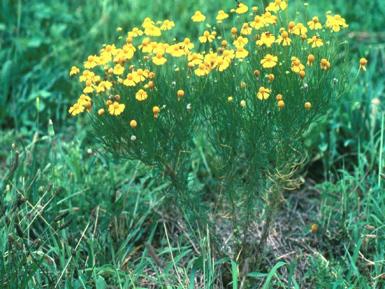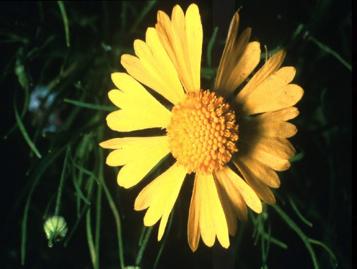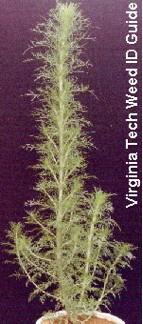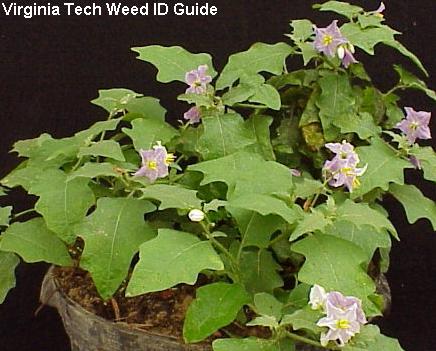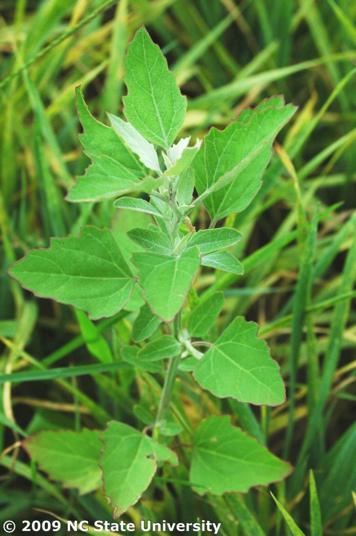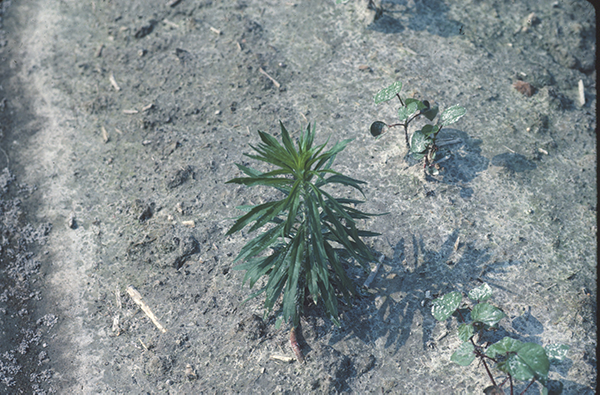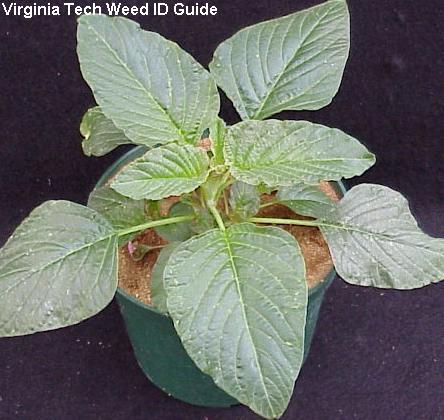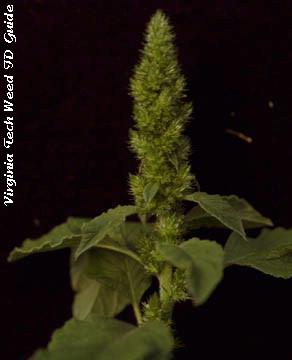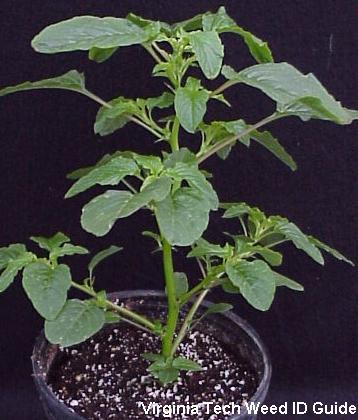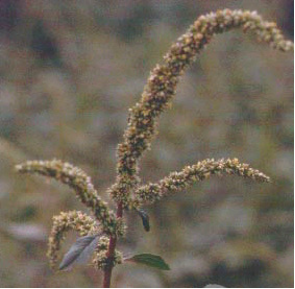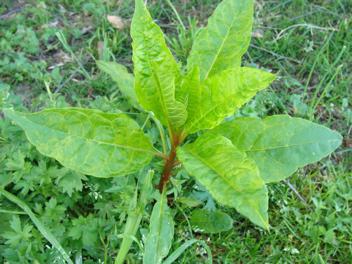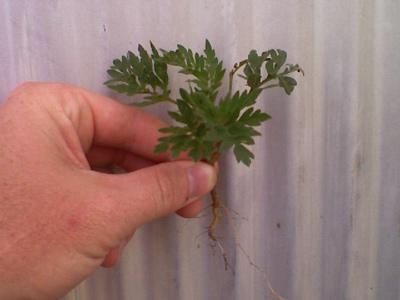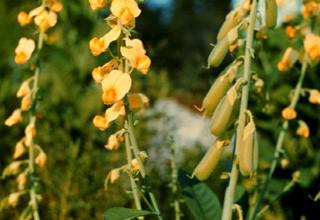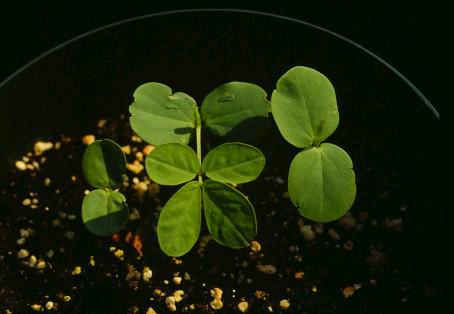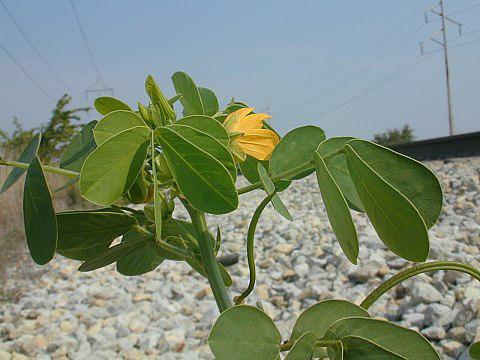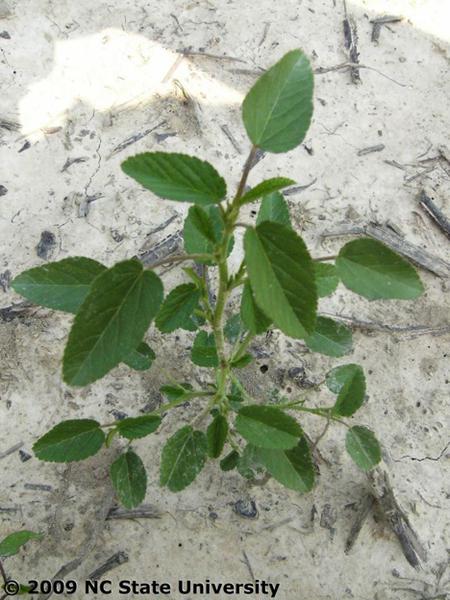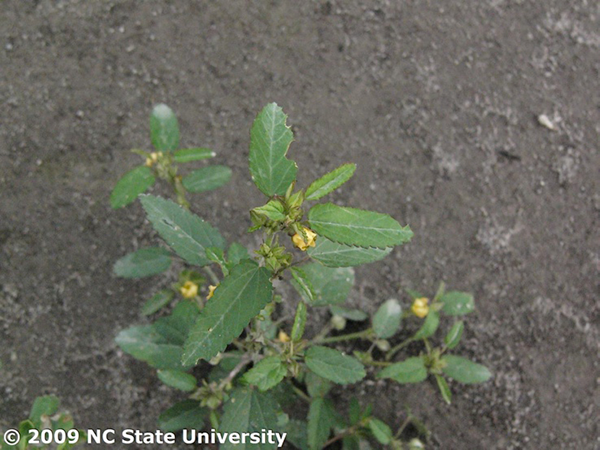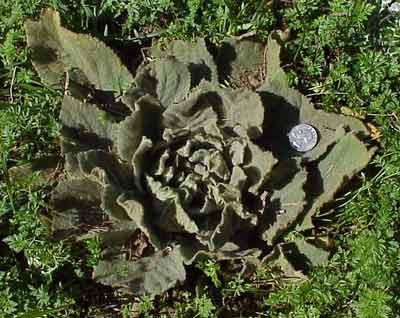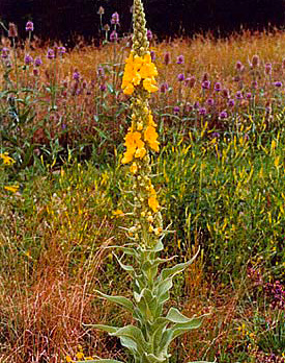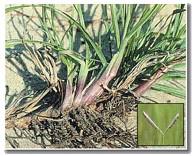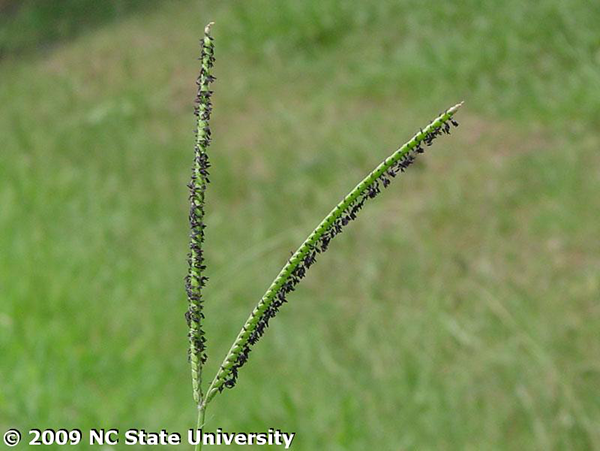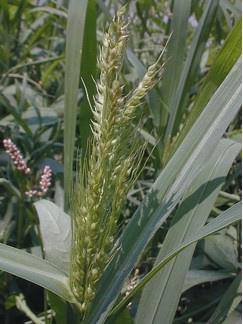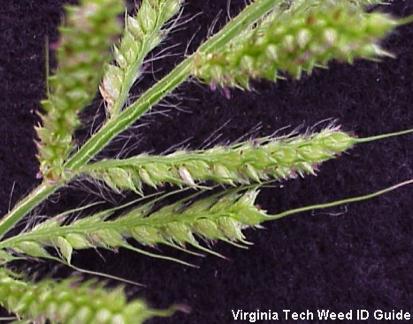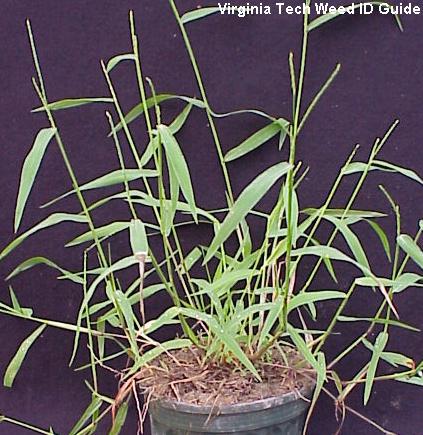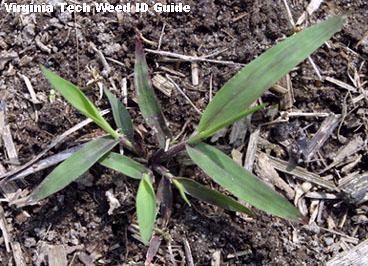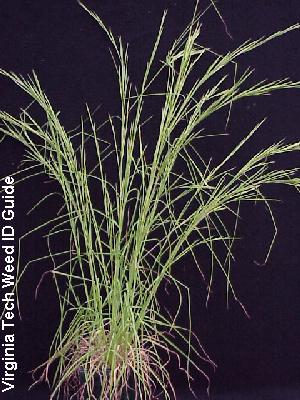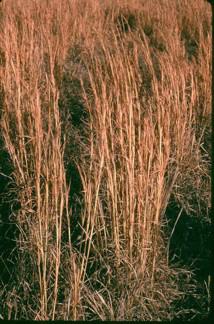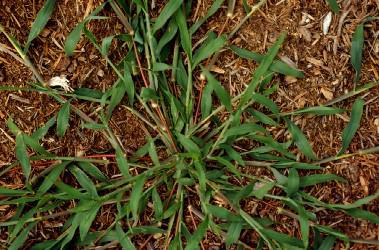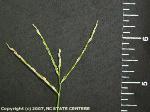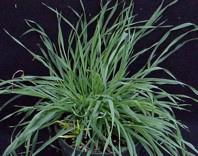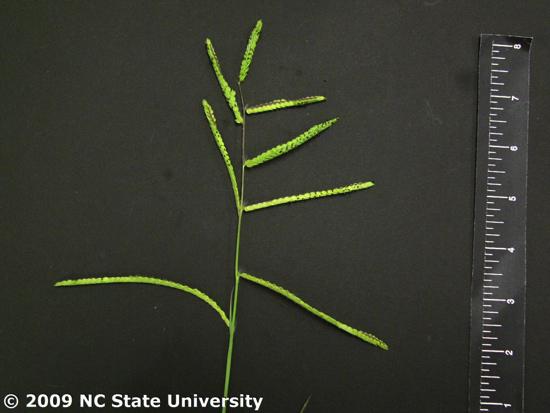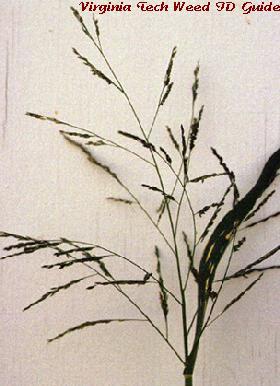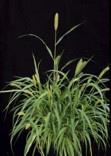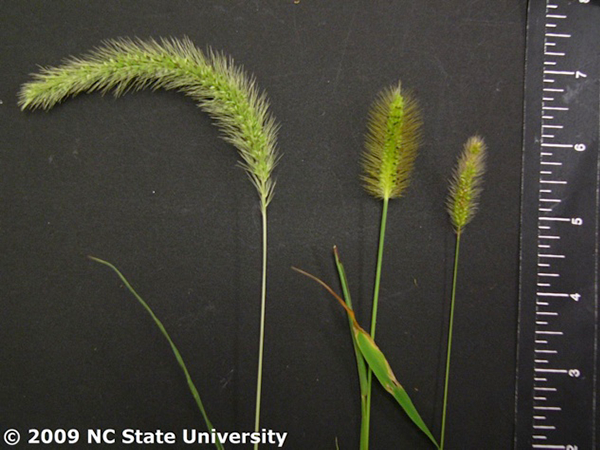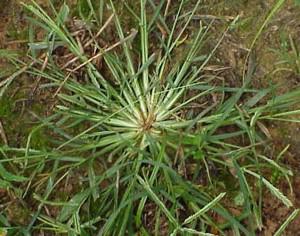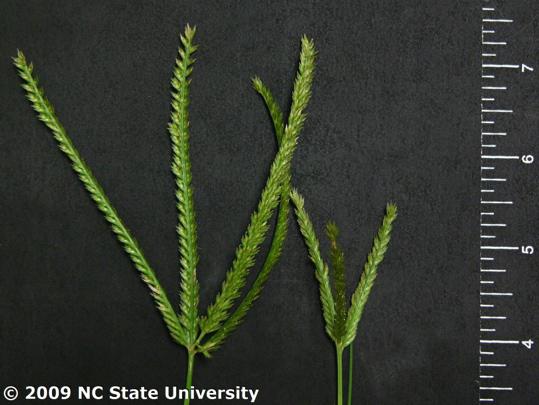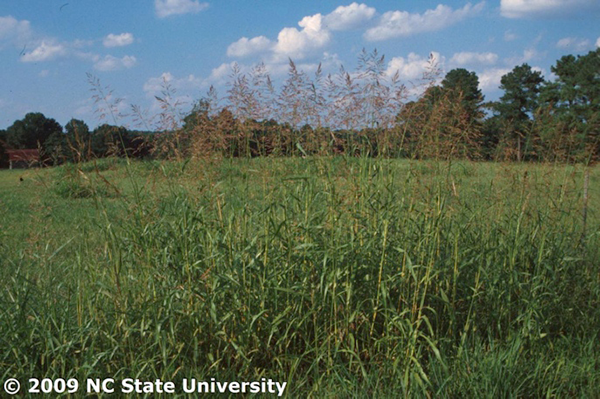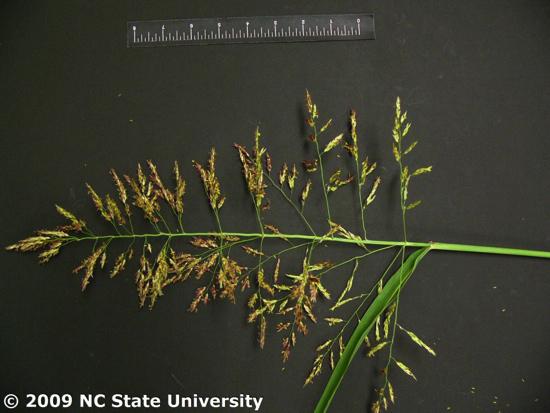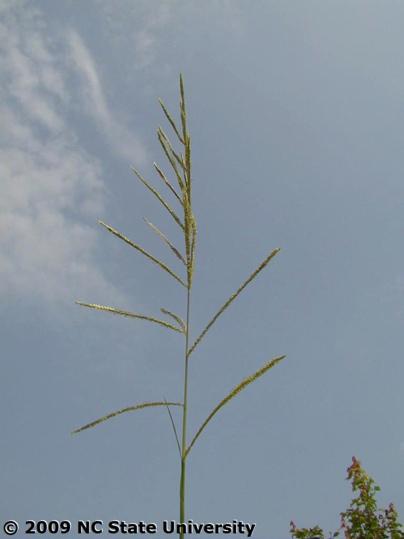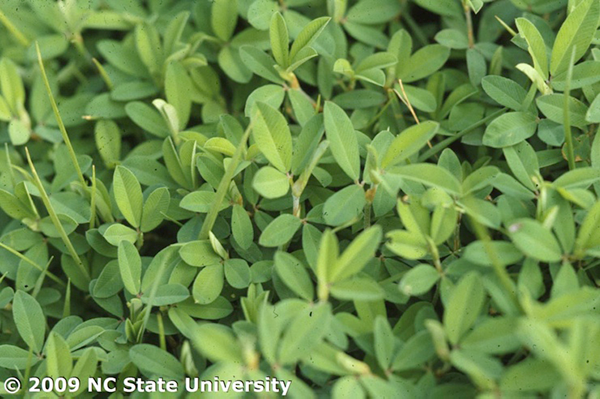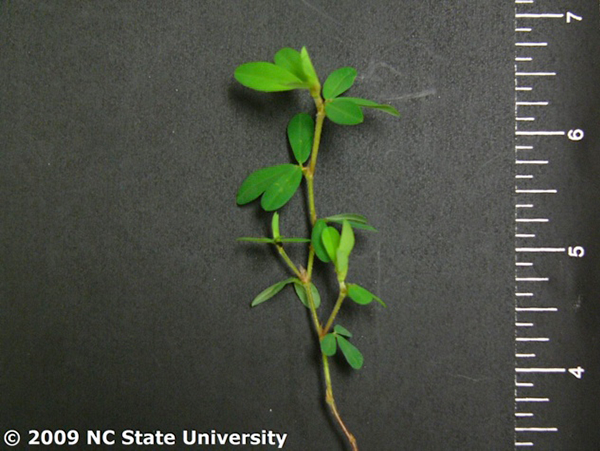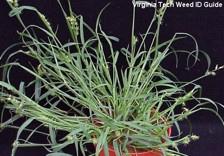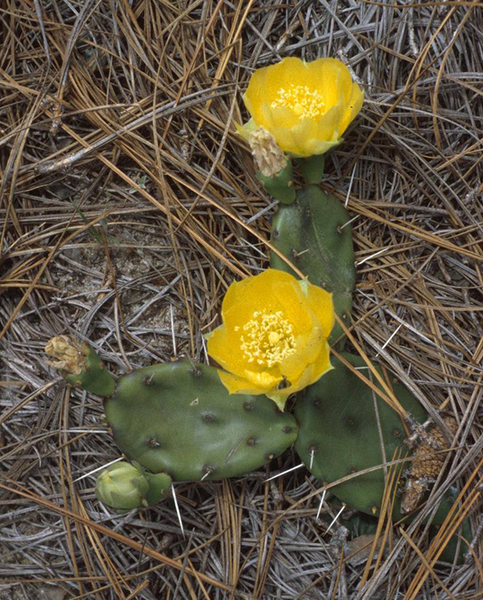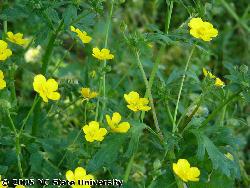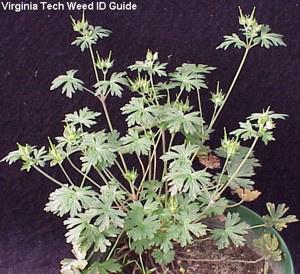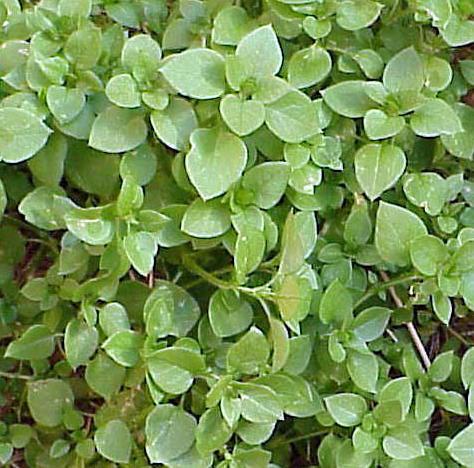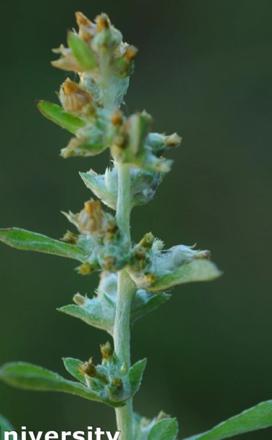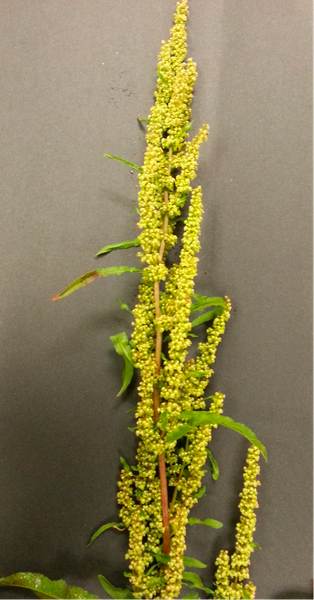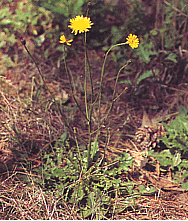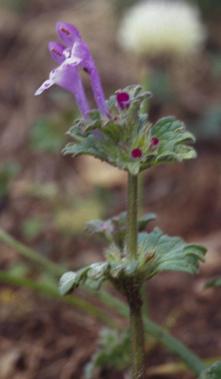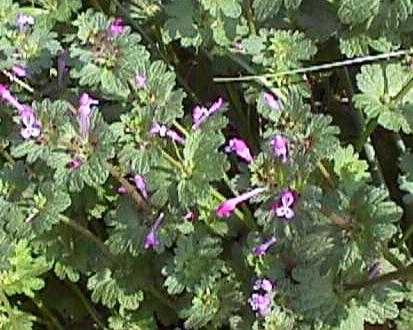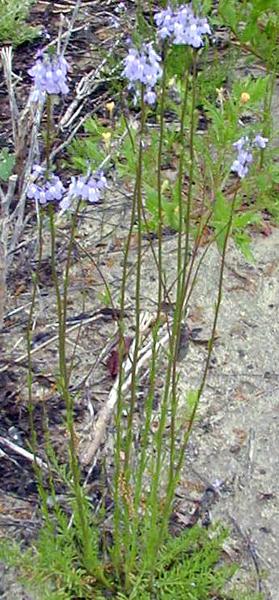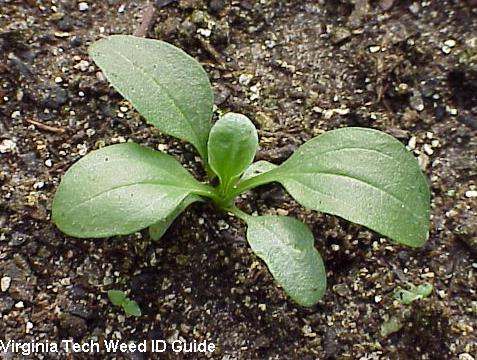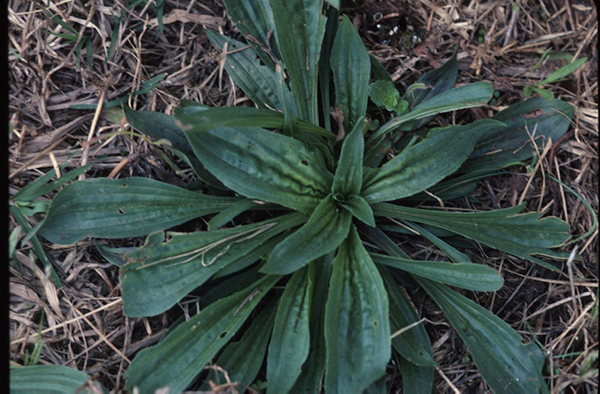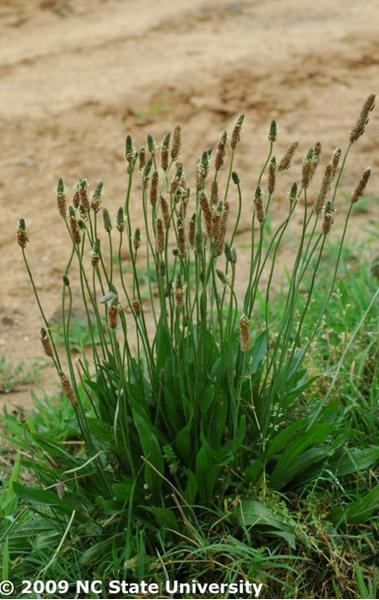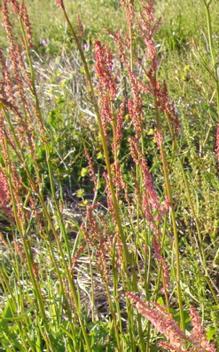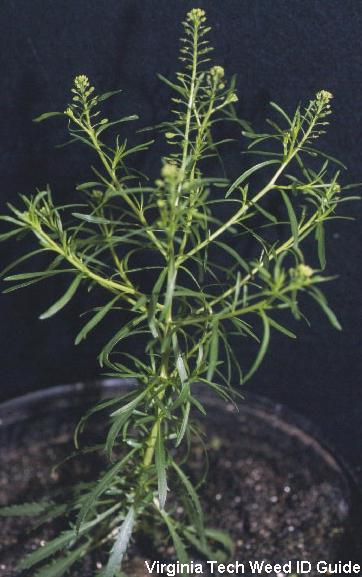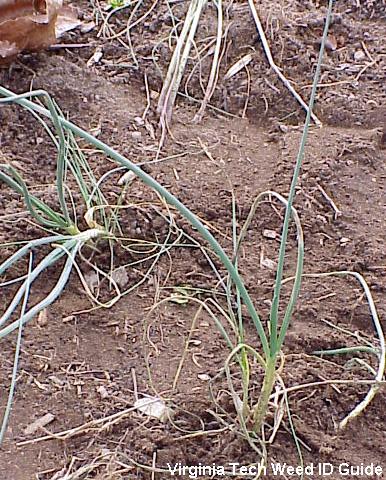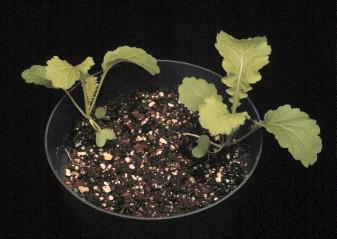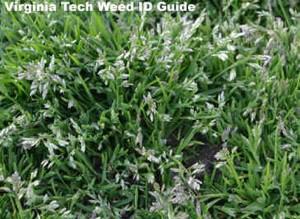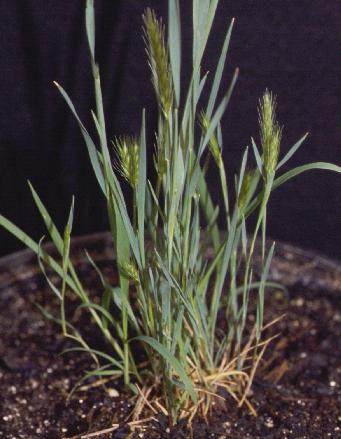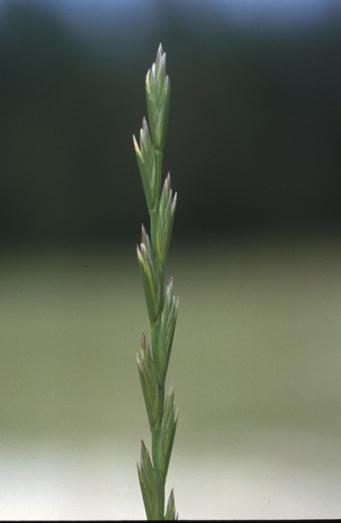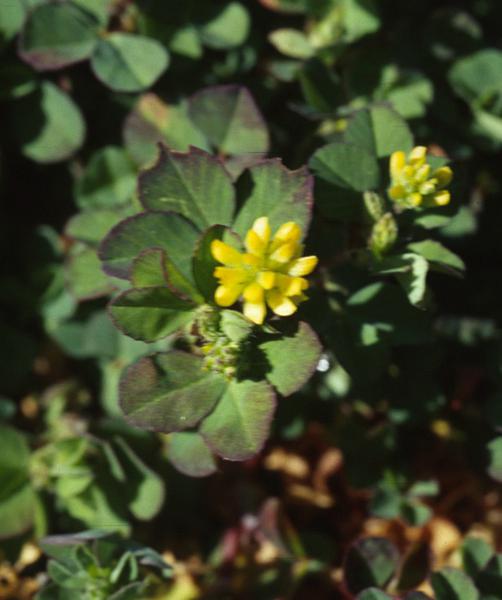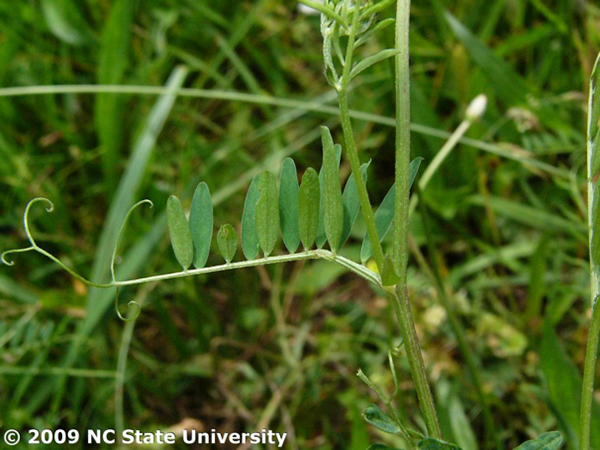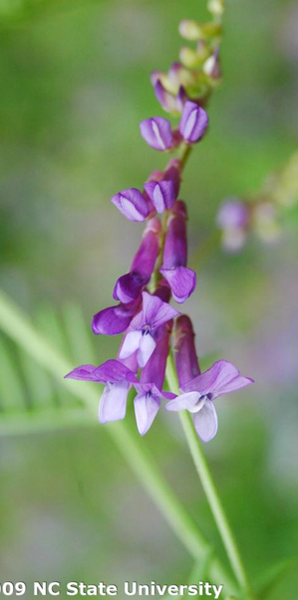This publication is designed to help you identify common weeds found in southeastern North Carolina pastures, hayfields, and sprayfields. It presents descriptions and pictures of some of the most common weeds, and it provides references for other weeds that are not in this publication. Weeds are categorized here as broadleaf, grass, or other, and as warm season or cool season. This publication does not recommend specific chemical control methods because differences in situations, rapidly changing labels, and new products make generalized recommendations impractical. Call your local Extension agent to discuss the best control methods for your farm.
Why Identify Weeds?
A weed is a plant growing in a place where you do not want it to grow. In pastures and hayfields, it is impossible to have a “pure” stand of grass; there will always be plants that volunteer from the seedbank or from neighboring fields. New volunteer species can mean more and better pasture forage, or it can mean losses of forage quality and yield. Weeds also have the potential to cause injury or death to livestock if the weed plants are toxic. Weeds can reduce hay yield and quality, and they can interfere with hay drying. For these reasons, weed control is very important.
The first step in weed control is identifying the weed or weeds you have, which will allow you to determine whether they need to be controlled. Take time to walk through your fields and scout at least 10 to 15 sites in a field. Identify all the plants and seedlings at each site. A good time to assess your fields is between seasons and about 1 week after cutting or grazing. Keep a record of the weeds you have in each field and when you start seeing them. This will help you determine whether your control program is working. Some weeds may take a few years to get under control.
Prevention is any activity that keeps weeds from getting into your pasture. Many weeds are spread by seeds that are dispersed by hay bales, plants that reach maturity, livestock movements, mowing equipment, wind, water, and wildlife. Weeds can also be introduced when you plant grass seeds that are contaminated with weed seeds. When you buy seed, make sure you are getting the best seed for your money. This is why certified seeds are recommended.
Cultural control increases the competitiveness of forage. Fertilizing to improve soil pH and fertility maintains grass stands and decreases weed competition. Once you are sure soil fertility and pH are correct, use the four control methods below in combination to fight weeds. The effectiveness of control methods depends on timing.
- Grazing management is one way to control weeds in a pasture situation. This control allows desired plants to become strong and outcompete the weeds. Rotational grazing helps to control weeds by giving desired plants the opportunity to rest and grow undisturbed before being grazed again. In rotational grazing systems, animals will often consume weeds they would avoid in continuous grazing systems. Graze or mow at the proper height, and do not cut or mow too short.
- Mechanical control usually involves mowing to control weeds. Mowing is usually more effective on broadleaf weeds than grass weeds. Mowing does have negatives: it increases fuel costs, it may not help with large weeds, and it can spread seeds around, encouraging more weed growth. If there is no chemical control labeled for a particular weed or if weeds are too mature, mowing may be your only choice for decreasing competitiveness. Burning, when safe and permitted, is another option for control of some weeds in some forages.
- Biological control involves the use of natural agents such as plants, herbivores, insects, and nematodes to suppress weeds. Biological control is a relatively new area, but progress is being made in developing and refining biological control methods. Biological control is usually not complete and may take several years to become sufficiently effective.
- Chemical control is the use of herbicides that kill weeds by inhibiting the plant growth process. Select an herbicide based on desired forage species, weed species present, cost, and ease of application. It is very important to apply herbicides at the correct time and rate. Consider spot-spraying weeds.
The best time to control weeds postemergence with herbicides is when the weeds have germinated, are young, and are actively growing. This time varies according to whether the weeds in question are cool-season weeds or warm-season weeds.
Cool-season weeds: The best time to control with herbicides is from October through December. It is also possible to control cool-season weeds from February through April.
Warm-season weeds: The best time to control with herbicides is from April to mid-July for most species.
Always read and follow herbicide label directions, and pay attention to any grazing and haying restrictions. The label is the law!
Plant Glossary
ALS-inhibiting herbicides—A class of herbicides that inhibit synthesis of branched amino acids in plants by inhibiting acetolactate synthase (ALS).
Alternate—A type of leaf arrangement characterized by a single leaf at each node.
Annual—A plant that germinates, flowers, and produces seed in one year.
Apex—The tip of a leaf or other plant part.
Auricle—A clawlike appendage projecting from the collar of the leaf in a grass plant.
Awn—A fibrous bristle or beard that is an extension of the midrib of the large outer bract.
Basal—A new plant arising from the base of the stem.
Biennial—A plant that generally lives two years, forming the vegetative structures (roots, leaves) in the first year and the reproductive structures (fruits, seeds, flowers) in the second year.
Blade—The flat portion of the grass leaf above the sheath.
Bract—A modified or specialized leaf.
Broadleaf—Plants with flattened leaves; dicots, i.e., plants that possess two seedling leaves. Leaves are generally wider than they are long and have netlike veins. They can have either round or square stems, and growth can be upright, prostrate, or vining. Broadleaf plants can have a taproot, a bulbous root, or fibrous roots. They often have showy flowers. Three key indicators help categorize a plant almost definitively as a broadleaf, rather than a grass, rush, or sedge: a square stem, a nonlinear leaf shape, or a nonfibrous root system.
Bunchgrass—A nonspreading grass that lacks rhizomes and stolons.
Cladodes—Swollen, water-storing stem segments that are not leaves.
Collar—A narrow band marking the place where the blade and sheath of a grass leaf join. A divided collar is divided by the midrib, and a continuous collar is not divided by the midrib.
Cool-season plant—A plant that exhibits optimum growth during spring and fall months.
Cotyledon—A leaf of the embryo of a seed plant that, upon germination, either remains in the seed or emerges, enlarges, and becomes green.
Crown—A region of compressed stem tissue from which new shoots are produced, generally found near the surface of the soil.
Cultivar—A word derived from two words, «cultivated variety,» referring to any cultivated variety of a particular plant species.
Dormancy—A period when growth and development is temporarily suspended.
Fibrous roots—A root system made up of many threadlike members of more or less equal length, as in most grasses. A fibrous root system serves to anchor the plant.
Flower—Reproductive structure of some seed-bearing plants, characteristically having either specialized male or female organs or both male and female organs, such as stamens and a pistil, enclosed in an outer envelope of petals and sepals. This structure usually has showy or colorful parts.
Inflorescence—The flowering part of a grass or broadleaf.
Keeled—A descriptor for a longitudinal prominence on the back of a structure.
Lateral—On the side.
Leaf—An extension of a plant’s stem that is primarily the plant’s food-making organ in photosynthesis.
Leaf axil—The location where the petiole attaches to the stem.
Leaflet—One of the segments of a compound leaf.
Legume—A plant that belongs to the family Leguminosae (or Fabaceae). Legumes live in a symbiotic relationship with bacteria that reside in structures on their roots called nodules. These bacteria are able to take nitrogen from the air, which exists in a form that plants cannot use, and convert it into compounds that plants can use.
Ligule—A membranelike tissue or row of delicate hairs typically found in grasses at the junction of the leaf sheath and blade.
Lobe—A rounded portion of a leaf.
Midvein—The vein in the center of a leaf.
Node—A joint in a stem, rhizome, or stolon.
Opposite—A type of leaf arrangement in which the leaves grow in pairs on opposite sides of the stem but at the same height on the stem.
Palmate—Descriptor for veins that originate from the base of the leaf and radiate out toward the outer edges of the leaf (in the shape of a palm).
Panicle—A type of seedhead with multiple seeding branches around the stem. Sometimes roughly triangular in shape.
Parallel—Descriptor for veins that begin at the base of the leaf and run lengthwise along the whole leaf.
Peduncle—A stalk bearing a flower, flower cluster, or fruit.
Perennial—A plant that generally lives longer than two years.
Petiole—The stalk of a leaf that attaches the blade to the stem.
Pinnate—Descriptor for veins that do not appear to begin or end in one place but rather form a net of veins.
Primary root—A root that originates in the seed as part of the embryo, normally being the first organ to grow. It grows downward into the soil and produces lateral secondary roots that emerge at right angles behind the root tip. Sometimes it persists and thickens to form a taproot.
Prostrate—A low-growing growth pattern, parallel to and hugging the ground. May form new roots at the nodes.
Raceme—A type of seedhead consisting of spikelets attached along the end of the stem or attached at one point at the end of the stem.
Rhizome—An underground creeping stem capable of producing roots and tillers at the nodes.
Rosette—A plant that has a cluster of leaves that grow in a circle at ground level. The plant will most likely also have one upright stem form in the center of the rosette late in the growing season.
Secondary root—A root arising from a primary root.
Sedge—A plant very closely resembling a grass. Can be distinguished from grasses by the solidly triangular stem section.
Seedhead—The dry fruit containing seeds. They can be open-panicle types, compact spikes, or racemes.
Sepal—A modified leaf that is part of the outermost of the four groups of flower parts. The sepals of a flower are collectively called the calyx.
and act as a protective covering of the inner parts in the bud.
Sheath—The portion of a leaf base surrounding the stem of a grass. Can be open, closed, or split with overlapping margins, depending on the species of grass.
Spike—One type of seedhead of grass, at the end of the stem, not branched.
Sprig—A rhizome or stolon of a grass, harvested and transplanted to establish a pasture or hayfield.
Stem—The stalk of a plant that supports a leaf, flower, or fruit.
Stolon—An aboveground creeping stem capable of producing roots and tillers at the nodes.
Summer annual—A plant that germinates, flowers, and produces seed in one year and that exhibits optimum growth during summer months.
Surfactant—An additive typically used with herbicides. The main types of surfactants are cationic, anioinic, and nonionic. The most commonly used type is nonionic.
Taproot—A main root that grows straight down from the stem and gives off small lateral roots.
Tiller—An emerging grass plant shoot.
Translucent—Permitting the passage of light.
Trifoliate—Typically consisting of three leaflets. Clover is an example of a trifoliate plant.
Tuber—An underground stem attached to the root system and storing carbohydrates.
Venation—The appearance of veins in a leaf; either pinnate, palmate, or parallel.
Vernation—The arrangement of an immature leaf in the bud shoot; either rolled or folded.
Warm-season plant—A plant that exhibits optimum growth during summer months.
Winter annual—A plant that establishes from seed, grows, sets seed, and dies in one growing season, beginning with germination in the fall and dying in the spring or summer.
Warm-Season Broadleaf Weeds
Alligatorweed is a perennial weed that is a mat-forming member of the Amaranth family. It is a serious aquatic weed problem in the North Carolina coastal plain and is becoming a major pest in pastures and row crops in low-lying areas. Alligatorweed stems are distinctly jointed and hollow except at the nodes. The stems are light green in color, with faint darker green parallel lines extending from one node to the base of the next. Roots are produced at the nodes. Terrestrial infestations produce two types of rhizomes: purplish, horizontal rhizomes that resemble stems with very short internodes, and fleshy, white, rootlike rhizomes. Terrestrial stems usually are pithy or even solid, rather than hollow. Leaves are oval to lance-shaped, have a prominent midrib, and are arranged opposite along the stem. Small, cloverlike, white flowers are borne on short stalks attached in the leaf axils near the end of the stems. Flowering occurs from late April through October. Reproduction is vegetative by fragmentation because very few seeds form.
Bitter sneezeweed is an upright, branching annual weed that reaches 10 to 20 inches tall. It has a strong taproot and a purple stem. The weed’s water requirement is low, ideal exposure is full sun, and it reproduces by seed. A member of the sunflower family, the plant has two varieties that are identical except for the flower color: one is completely yellow, and the other is yellow with a red-brown center. The flowers are noticeable in the late spring or summer and are located at the end of each branch. Each bloom has about eight cleft ray flowers with three lobes, often bending downward at maturity. Leaves are small, thread-like, numerous, and located alternately on the stem. Basal stem leaves are usually absent at flowering. The entire plant has a strong odor and is bitter to the taste and toxic to livestock.
Dogfennel is a perennial weed. It can grow more than 6 feet tall. The leaves are divided into very fine, somewhat indistinct segments. The stems are hairy, especially when young, but leaves are always hairless. The stems are soft and easily broken when young, but they become very tough and woody as the plant ages. When crushed, the leaves and stems have a very distinct odor that is slightly sour and musty.
Horsenettle is a perennial plant from rhizomes with obvious spines on the leaves. The plant can reach 3 feet in height. Leaves are elliptic-oblong to oval, alternate, petioled, 2½ to 4½ inches long, and covered on both surfaces with hairs. Stems are angled at the nodes, become woody with age, and have prickles and hairs. Flowers occur in clusters and are star-shaped, with five white to violet petals and a yellow center. The fruit is a berry, green when immature, turning yellow and wrinkled with maturity. The plant is capable of poisoning livestock if eaten in sufficient quantity; however, consumption rarely occurs due to the prickly stems and leaves.
Lambsquarter is an annual weed that grows upright, 1 to 4 feet tall, with many branches. The leaves have a wavy or coarsely toothed margin with a soft gray or white mealy coating on young leaves and on the undersides of mature leaves. The flowers are unremarkable gray-green in dense clusters in leaf axils and branch tips. It is a rapid-growing weed with high water use and is very competitive in most situations.
Mare’s tail, or horseweed, is an annual weed. It is an erect weed that can reach 6 feet when mature. Leaves will be 3 to 4 inches long at the base and will taper off toward the top of the plant. The mature plant will flower out later in the summer and will have white or pink flowers.
Pigweed and amaranth are annual weeds. There are approximately 60 species, with foliage ranging from purple and red to gold. They have an extended period of germination, rapid growth, and high rates of seed production. They can become resistant to ALS-inhibiting herbicides if used continuously. They have red stems and egg-shaped, wavy-margined, alternate leaves and can reach 6½ feet in height. Stems and leaves may or may not be hairy. They have a shallow taproot that is often reddish in color. They have small, green, flowers that are not noticeable and that are produced in dense, compact panicles that are approximately ¾ inch wide and from 2 to 8 inches in length. These weeds are often confused with lambsquarter. Pigweed can be very toxic if eaten in large quantities because of the potential nitrate accumulation. Spiny amaranth and redroot pigweed are the two most common types that thrive in disturbed soils.
Spiny amaranth has pairs of spines at the base of the leaf petiole and the central stem. The spines of spiny amaranth help to distinguish it from all other closely related pigweed species. Redroot pigweed has dense, compact terminal panicles and relatively tall plants with alternately arranged leaves.
Pokeweed is a perennial weed that can grow from 1 to 10 feet tall. It has single alternate leaves with points at the end and crinkled edges. The stems are often pink or red. The flowers are greenish white, in long clusters at the ends of the stems. The flowers develop into dark purple berries. Pokeweed usually grows along fence lines.
Ragweed is an upright annual weed with single leaflets that are deeply lobed, with hairs on the upper and lower surfaces. Leaves can grow to 2 or more inches wide. It has a taproot with many hairs. Flowers are not noticeable. Ragweed emerges in the spring, often in cultivated areas, but is also found in pastures and along roadsides and ditches. It prefers heavier soils.
Showy crotalaria is an annual weed/legume with relatively showy yellow flowers and distinctive seedpods. The stout, erect stem reaches 6 feet in height and is green or purplish in color. Stems become waxy and somewhat angled with age. Leaves are alternate, approximately 2 to 6 inches long, widest at the apex and tapering to the base. Leaves are without hairs on the upper surface and covered with hairs on the lower surface. Once mature, it will produce large, bright, yellow flowers. Showy crotalaria can produce fruit pods that are 1 to 2 inches in length and take on the appearance of an inflated cylindrical pod. The fruit turns brown to black when mature, and the seeds within the fruit often become unattached, resulting in a “rattlebox” sound when shaken. Seeds are considered mildly toxic and can cause problems if consumed in large quantities.
Sicklepod is an annual weed with erect, nearly hairless stems, reaching 1 to 6 feet in height. It is a plant with yellow flowers; long, narrow seed pods; and multidivided leaves, with the terminal pair of leaflets being the largest. The fruit is a long pod, and the seed is inside. Sicklepod has a taproot. The leaflets are also photosensitive. The leaflets fold upward by flexible petioles at night or on cloudy days. The pods are green and turn brown as the seeds mature. Sicklepod plants and seeds are potentially toxic.
Sida species, also known as ironweed, are erect annual weeds commonly found late in the season. The two main species are prickly sida and arrowleaf sida. Sida species stems grow 8 to 20 inches long. They have yellow flowers with five petals that can be solitary or in clusters. Both species seedlings have two heart-shaped cotyledons and small spines that occur at the base of each leaf petiole. The cotyledons of arrowleaf sida are essentially identical to those of prickly sida; however, the first true leaf of arrowleaf sida is widest above the middle and tapers toward the leaf base.
Woolly mullein is a biennial weed. The first year, it produces a rosette; the next year, it produces a stalk with yellow flowers. It is a hairy plant that can grow to 6 feet or more in height. It has small, yellow flowers that are densely grouped on a tall stem that protrudes from a large rosette of leaves. It prefers well-lit, disturbed soils, where it can appear soon after the ground receives light, germinating from long-lived seeds that persist in the soil seed bank. It is intolerant of shade from other plants and unable to survive tilling. It also hosts many insects, some of which can be harmful to other plants. Although individual plants are easy to remove by hand, populations are difficult to eliminate permanently.
Warm-Season Grass Weeds
Bahiagrass is a commonly found perennial grass that spreads by rhizomes and is easily recognized by its characteristic Y-shaped black seedhead. This fast-growing invasive grass forms a dense, low-growing sod, with small, narrow leaves. Bahiagrass can be used as a forage grass.
Barnyardgrass is an annual with thick stems that may reach 5 feet in height. Barnyardgrass is one of the few grass weeds in which ligules are absent. Leaves are without hairs or auricles. The leaf sheaths are often tinted red or maroon at the base. The leaves are smooth and rolled in the shoot. Leaves range from 4 to 20 inches in length and may be 0.2 to 1.2 inches wide. Leaves have a distinct white midvein that becomes keeled toward the basal portions of the leaf. A few short hairs may occur at the leaf bases.
Broadleaf signalgrass is a spreading annual often found growing along the ground with tips ascending. Stems are bent at the nodes, and the plant may also root at the nodes that touch the ground. The plant may reach 3 feet in height. The leaf sheaths and blades are often maroon-tinged. The leaf blades are 1½ to 6 inches long and 0.2 to 0.6 inches wide; they are wider at the base and taper toward the tip. Signalgrass has a narrow, membranous ligule 0.02 to 0.04 inches long, fringed with hairs. The roots are fibrous. The seedheads are racemes, each with two to three "branches." The spikelets are somewhat flattened in appearance. The plant is most identifiable by the short, wide leaves, rooting nodes, flattened spikelets, and lack of hairs on the leaf blades.
Broomsedge is also called Virginia bluestem or broomstraw. Broomsedge is a perennial grass that forms clumps. It often goes unnoticed until it matures into a reddish-brown clump of broomlike stems. The plant sends up slender stems that can reach 3 feet tall in late summer. The stems produce numerous white, windborne seeds. It grows on nutrient-poor soils and is especially tolerant of low pH and low levels of nitrogen and phosphorous. In the springtime, the grass produces clumps of curly, boot-top-tall blades, but the fodder provided is short lived. Broomsedge’s ability to produce allelopathic chemicals suppresses the germination and growth of competitive species. In effect, it makes its own natural weed-killers.
Crabgrass is an annual grass with seedlings that sprout quickly, forming a clump with extensive roots. Large crabgrass seedlings are pale green and covered with coarse hairs. It has a membranous ligule and no auricles, with young leaves rolled in the bud. Plants form open clumps up to 2 feet tall. Once established, it is difficult to weed out because it roots at the nodes. Smooth crabgrass can be distinguished from large crabgrass by its shorter, wider leaf, blackish-brown bract, and lack of hairs. Both are highly palatable, good-quality forages.
Dallisgrass is a perennial grass often mistaken for crabgrass species. The leaf appearance is very similar to crabgrass. It can be readily identified by its seedhead, which has hairy spikelets in four rows on three to eight alternate branches. It has short, thick rhizomes. Rank seedheads in late summer can be infected with an ergot-like fungus, turning them gray to black and sappy. Cattle eating a significant amount of the infected seedheads can develop an illness called dallisgrass staggers, which is serious but not usually fatal. Dallisgrass can be used as a forage grass.
Fall panicum is an annual grass with large, round, smooth sheaths that are often bent at the nodes. This weed may reach 7 feet in height. A primary identifying characteristic is the “zigzagged” growth pattern it takes on due to bending at the nodes. There are hairs on the lower leaf surface. The leaves are rolled in the shoot and are 4 to 20 inches long, and auricles are absent. The ligule is a fringe of hairs reaching 0.08 to 0.1 inch in length and is often fused at the base. Leaf blades have an obvious midvein and are smooth above but sometimes slightly hairy near the leaf tip or leaf base. Nodes along the stem are usually swollen and bent in different directions, which contributes to the rather unusual growth habit of this weed. It has a fibrous root system with stems that are capable of rooting at the nodes. The seedhead is a wide, spreading panicle that develops a purplish tint when mature. Individual spikelets are yellow and approximately 0.1 inch long by 0.08 inch wide.
Foxtail is a name for three different species of annuals. All are very similar grasses and can mainly be differentiated when mature. Foxtail is a clump-forming grass with a seedhead that resembles a fox’s tail. Giant foxtail has characteristic foxtail-like seedheads that droop when mature and leaves with many hairs on the upper leaf surface. Giant foxtail is generally larger and has a nodding seedhead, unlike the other foxtails. Yellow foxtail has a characteristic foxtail-like seedhead that appears yellow when mature; its leaves have long, silky hairs at the base only. Green foxtail has a characteristic foxtail-like seedhead and leaves with no hairs.
Goosegrass is an annual grass that requires moisture and light for germination. Goosegrass has a prostrate growth habit and is often white in the center with a wagon-wheel-like appearance. It does not root at the nodes, but it grows well in compacted soils. Leaf sheaths are flattened, smooth, and distinctly white to silver at the base. Goosegrass has a fibrous root system. The seedhead is composed of two to thirteen spikes each that are 1½ to 6 inches long and 0.1 to 0.3 inch wide, growing in clusters at the top of stems. Two rows of flattened spikelets occur along each spike. Each spikelet contains three to six light brown to black seeds that are 0.04 to 0.08 inch long. Plants often appear compressed to the soil as if they have been repeatedly stepped on. The distinctive white center of goosegrass distinguishes it from most other grass weeds.
Johnsongrass is an aggressive perennial grass that spreads by rhizomes and seeds. It is a very tall, coarse grass with stout rhizomes. It grows in dense clumps and can reach 8 feet in height. The leaves are smooth, 6 to 20 inches long, and have a prominent white midvein. The stems are smooth and pink to rusty red near the base. Panicles are large, loosely branched, purplish, and hairy. Spikelets occur in pairs or threes, and each has an obvious awn. Seeds are reddish brown and nearly ⅛ inch long. The roots are fibrous. Rhizomes are found close to the soil surface and are stout with purple spots and scales at the nodes. Johnsongrass can be poisonous to livestock after it becomes wilted from frost or new growth following a drought or cutting. During hot, dry weather, johnsongrass can contain enough prussic acid to kill livestock if eaten in any quantity. It can cause death from nitrate poisoning.
Vaseygrass is a medium-large perennial grass. The stems are tufted and grow to 7 feet tall. The leaf blades are long and narrow, up to 2 feet long, and ½ inch wide. The leaves are smooth, with long hairs at the base. The sheath is hairy at the base of the plant. Vaseygrass has a prominent membranous ligule.
Warm-Season Other Weeds
Common lespedeza is a mat-forming, wiry-stemmed, prostrate, freely branched annual broadleaf weed. It has dark, green, trifoliate (arranged in threes) leaves with three oblong, smooth leaflets. The leaflets have parallel veins nearly at right angles to a prominent midvein. The leaves have smooth edges and a short spur at the tip of each leaflet. It also has a semiwoody taproot and grows close to the ground. It flowers in late summer with pink to purple flowers. Single flowers are found in leaf axils on most of the nodes of the main stems. Lespedeza can be used as a forage crop.
Field sandbur, or sandspur, is an annual weed. Sandburs are a lighter shade of green than most other grass weeds. The leaves are rough. The roots require careful handling because the seed is actually a bur. It has a membranous ligule that has little hairs on the top of it and a flattened stem. Field sandbur is found mostly on sandy soils. It is troublesome mainly because the green or brown spiny burs can cause discomfort to livestock. The burs are dispersed when they cling to animals, people, clothing, or equipment. The stems may be erect or spreading, are often bent near the base, and are highly branched. They grow from 6 inches to 1½ feet tall and appear flat in cross-section. The plant’s leaves are flat (folded when budding). The leaves usually have a raised midvein and few or no hairs. The base of each leaf forms a sheath that extends down the stem. The point where the leaf base joins the sheath is often lighter in color and hairy. The plant has a shallow, fibrous root system that emerges from the plant base. It reproduces through seed only and competes poorly with other plants.
Nutsedge (yellow and purple) is sometimes incorrectly called nut grass, but it is a sedge. Sedges can be distinguished from grasses by the stem. Sedges always have a three-sided or triangular stem. Yellow nutsedge is native to North America and is a fairly cold-tolerant sedge. Purple nutsedge is a native of India and is more commonly a problem in warm-season grasses. Both species are perennials that produce tubers on underground rhizomes. The two species can be distinguished by the color of the seedheads and location of the tubers on the rhizomes. Yellow nutsedge has a yellowish-tan seedhead, whereas purple nutsedge has a red-purple seedhead. In yellow nutsedge, the tubers only grow on the ends of rhizomes, while purple nutsedge will grow tubers in a chain connected by rhizomes. Yellow nutsedge has tubers of a chestnut (tan) color, and purple nutsedge has hairy tubers of a charcoal (black) color. Purple nutsedge is generally more difficult to control, so positive identification is important.
Prickly pear is a low-growing cactus with showy yellow flowers and pads that have many individual prickles consisting of tufts of needlelike spines. It is a perennial cactus that is native to most of the United States. Prickly pear has many pads (called cladodes) with tufts of needlelike spines. The prickly pear has no true leaves present. It has a thick rootstock. Pads are able to root and aid in the spread of this species. Each pad is a stem that is succulent and thick, containing many individual spines. Upon closer examination, it becomes apparent that some of the spines (less than ½ inch long) actually consist of many very small “needles” that can very easily stick in skin, clothing, fur, etc. Pads also contain some spines that are approximately 1 inch long that do not divide in this manner. Pads that become detached from the parent plant have the ability to root and form new plants in almost any location. The fruit is a cone-shaped capsule that is widest at the top, tapering to the base. Individual fruits are fleshy and grow to approximately 1 to 1½ inches long, turning red to maroon with maturity. The flowers are bright yellow in color, 2 to 3 inches wide, and sometimes have a reddish center.
Cool-Season Broadleaf Weeds
Buttercup is an annual or perennial broadleaf weed. There are two species common to North Carolina. Bulbous buttercup is common from the piedmont east through out the coastal plain while hairy buttercup is predominate from the piedmont west into the mountains. Both are common pasture weeds. They are annuals which reproduce by seed and can invade a field or pasture in one growing season. Bulbous buttercup can be distinguished by the bulbous swelling at the base of the stems. Both species have deeply lobed leaves and produce yellow flowers with (usually) 5 petals.
Carolina geranium is an annual weed that initially forms a basal rosette, with subsequent stem elongation and branching as the plant matures. The stems are erect, freely branching near the base to grow 28 inches tall. The stems are usually pink to red in color and densely hairy. It has divided leaves and distinctive “crane’s bill” fruit. The whitish-pink to purple flower color of Carolina geranium helps distinguish it from similar geranium species.
Chickweed is a low-growing annual. The leaves, which range from ½ inch to 1¼ inches in length, are light green in color and smooth or possibly hairy toward the base and on the petioles. Common chickweed has oppositely arranged small oval or elliptic leaves and stems with rows of hairs. Mouseear chickweed is very similar in appearance and growth habit, but this species is densely covered with hairs, unlike common chickweed.
Cudweed is an annual or biennial weed. In general, the cudweeds have basal rosettes, and the leaves and seedheads are covered in distinct, fine, white, woolly fibers. Some cudweeds only have this hair on the undersides of the leaves; other cudweeds have this hair on all surfaces. Cudweeds overwinter as small basal rosettes, but in the spring they usually grow an upright stem. The leaves are egg-shaped, and the plant has a taproot. The fruit bears bristly, white, tuftlike projections that are shed at maturity.
Curly dock is a perennial weed. Curly dock has a deep taproot, a basal rosette of wavy-margined leaves, and an unbranched stem that may reach 5 feet in height. Lower rosette leaves are petioled, lack hairs, are alternately arranged on the stem, and are dark green with wavy margins. The stem leaves are arranged alternately along the stem and have a membranous sheath that encircles the stem (ocrea) and becomes progressively smaller up the flowering stalk. The leaves become reddish-purple with age. As the plant matures, effective control becomes more difficult as the taproot develops.
Dandelion: Carolina false, common, and cat’s ear are three species of dandelion. Carolina false dandelion is a winter annual or biennial weed, whereas common and cat’s ear dandelions are perennials. The hairy leaves of Carolina false dandelion are deeply lobed and form a basal rosette with a taproot. The flower stalk can have many branches that end with flowers, unlike common and cat’s ear dandelion. Cat’s ear dandelion leaves are densely hairy, and the lobes of the leaves are more rounded than other dandelions. Common dandelion can be distinguished from cat’s ear dandelion because young leaves of common dandelion are hairless.
Henbit is an annual with square stems and pink-purple flowers, reaching 16 inches in height. The leaves are opposite, reach 5 inches in length, and are circular to heart-shaped, with hairs on the upper leaf surfaces and along the veins of the lower surface. The leaf margins have rounded teeth. The lower leaves occur on petioles, while the upper leaves are without petioles (sessile).
Oldfield toadflax is also known as common, blue, or purple toadflax. The plant can flower from early spring to late fall, depending on growing conditions. The small blue flowers have three lobes and basal spurs. The leaves are small, bright green, and linear. Small clumps of leaves will form in early spring, and the blue flowers will appear on long green stems shortly thereafter.
Plantains: blackseed, broadleaf, and buckhorn are perennial weeds that reproduce by seeds and roots. They form a spreading or upright basal rosette of narrowly oval leaves that grow above a long, sturdy taproot with lateral branches. The leaves of buckhorn plantain are longer and narrower than those of the other plantain species; they are also dark green, are sometimes twisted and curled, and grow up to 1½ inches wide and 8 inches long. The inflorescence of buckhorn plantain resembles a bullet. Broadleaf and blackseed plantain can be distinguished by the leaf petioles: blackseed petioles are usually red-tinged at the base, while broadleaf plantain petioles usually are not. Plantains form many small flowers that are tightly clustered at the ends of long stems.
Red sorrel is a perennial weed. It reproduces by triangular seeds and extensive, shallow, horizontal roots. It has arrow-shaped leaves; a slender, wiry stem with sheathed nodes; and a red to rust-brown color. Cotyledons are oblong and dull green. Seedlings resemble a rosette, made up of many leaves whose shape changes with age from egg- to spade- to arrow-shaped. Flowering stems are slender and erect, reaching heights from 6 to 18 inches. A sheath surrounds the stem like a collar until it turns brown and shatters with age. Leaves grow alternately along the stem. Lower leaves are long and spade-shaped with no lobes. Middle leaves are short and usually have a lateral lobe near the leaf base. Upper leaves are small with no lobes or stalks. Flowers are clustered at the stem top. Female flowers are greenish, and male flowers are yellow to red.
Virginia pepperweed is an annual weed that develops as a basal rosette initially, eventually producing flowering stems that have a bottle-brush appearance. Rosette leaves lack hairs, are oval in outline, and are lobed along both sides of the leaf. Rosette leaves do not usually persist once flowering stems are produced. The stems are erect and branched, and they reach 20 inches in height. The plant has a taproot. Individual flowers consist of four white or greenish white petals. The fruits are flattened and have a winged structure around the exterior.
Wild garlic and wild onion are perennial weeds that grow from bulbs. Wild garlic tends to persist later in the growing season than wild onion. Wild garlic sets a flowering stem that can have leaves growing off of it up to half its height, with a vegetative bud (bulbil) in the inflorescence instead of flowers. Wild onion leaves grow from the base of the bulb. Wild garlic is often confused with wild onion, but the two may be easily distinguished after a closer examination of the leaf cross-section. The leaves of wild garlic are hollow and round, while those of wild onion are flatter and more solid.
Wild mustard is an annual weed with characteristic yellow mustard flowers. The cotyledons are kidney-shaped to heart-shaped. The first true leaves are alternate, hairy, and elliptic in outline, and they have wavy margins. It has a taproot in combination with a fibrous root system. The leaves are alternate and egg-shaped to ovate in outline. The lower leaves occur as a rosette, are petiolated, and are unevenly lobed with toothed margins. Upper leaves become progressively smaller up the stem, are not lobed, and either clasp the stem or have short petioles. The stems are erect and are branched toward the top of the plant, and they usually have hairs at least at the base of the plant. The flowers are produced in clusters at the ends of branches. Individual flowers have four yellow petals and are approximately ¾ inch wide. The fruit is a dry and elongated with two valves that fall away, leaving a central partition.
Cool-Season Grass Weeds
Annual bluegrass (or Poa annua) is a clump-forming annual grass that tolerates close mowing; otherwise, it may reach 11 inches in height. It is primarily a weed of lawns and turfgrass, but it does grow in pastures. The leaves are light green. The leaf blades are ½ inch to 5 inches long, 0.04 to 0.2 inches wide, and folded in the bud; they lack hairs on either surface. Leaves have a distinctive boat-shaped tip. The ligule is slightly pointed and membranous. Leaf sheaths are somewhat compressed and flattened, without hairs. The seedhead is an open panicle that is ¾ inch to 2½ inches long. It has a fibrous root system.
Little barley is a short annual grass that resembles barley or wheat when mature. Little barley rarely reaches more than 2 feet in height and may occur as a weed of pastures, hayfields, and roadsides. Little barley stems range from 4 to 24 inches in height. It has a bluish-green color. The stems turn brown in the spring once the plant has matured. Leaf sheaths are round and usually do not have hairs, but they may occasionally have hairs present. The sheath also has split, overlapping, and translucent (hyaline) margins. Seedheads consist of flattened spikes that turn tan to brown when mature. The seedheads look like other small-grain seedheads. Each spikelet contains awns that may range from 0.08 to 0.5 inch in length.
Ryegrass is a grass that has two species. There is a perennial ryegrass, and there are several cultivars of Italian ryegrass that are annuals. Italian ryegrass often volunteers from seed. Both can be commonly found in pastures and cultivated areas as well as roadsides and ditches. Both have a spike seedhead with seeds alternating from side to side along the stem. Italian ryegrass can be distinguished from perennial ryegrass by some slight differences: Italian ryegrass has long, clasping auricles at the nodes, whereas perennial ryegrass has short, nonclasping auricles. Perennial ryegrass typically has 7 to 9 seeds on the seedhead, whereas Italian ryegrass will have 9 to 15 seeds or more. Also, Italian ryegrass will have an awn on the tips of the seeds, whereas perennial ryegrass does not. Ryegrass is often used for a winter cover crop, grazing, or hay.
Other Cool-Season Weeds
Hairy vetch is an annual or perennial herb in the pea family. It has a climbing stem that can reach 6½ feet. The whole plant has a white-woolly appearance because of its long, soft hairs. It has a shallow taproot system with strong lateral branches. It has 10 to 20 purple to blue flowers. Elongated, flattened pods contain two to eight rounded seeds ranging in color from dark brown to grey-black. Hairy vetch grows best in dry, sandy soils.
Yellow hop clover is an annual or biennial weed. The leaflets are toothed from midblade to tip. It can be distinguished by the sessile (not stalked) attachment of central leaflets. It has peduncles that are stout, stiff, straight, and often shorter than subtending leaves. It has no stolon or rhizome; it has upright, hairy, branched stems. The flowers are bright yellow, with 20 to 30 in loose clusters on long stalks attached at leaf axils. The flowers turn brown and fall back when mature.
Resources
North Carolina State University TurfFiles
Acknowledgments
Thanks to North Carolina State University’s Weed Science program and Virginia Tech University’s Weed Science program for the use of pictures and definitions.
Publication date: June 1, 2013
AG-764
N.C. Cooperative Extension prohibits discrimination and harassment regardless of age, color, disability, family and marital status, gender identity, national origin, political beliefs, race, religion, sex (including pregnancy), sexual orientation and veteran status.

